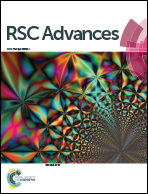Synthesis of stable CucoreAgshell&Ag particles for direct writing flexible paper-based electronics†
Abstract
Highly conductive flexible paper-based patterns were drawn directly using a brush pen dipped in ink consisting of copper–silver core–shell with individual silver (CucoreAgshell&Ag) particles. Using a cost-effective and green method, the formation of these CucoreAgshell&Ag particles is first driven by a transmetalation reaction on the surface of copper nanoparticles between copper atoms and silver ions, and then excessive Ag ions were further reduced by the glucose to form individual Ag nanoparticles. Characterization of these particles by XRD, SEM and TGA confirm the CucoreAgshell&Ag structure and their stability towards oxidation. The conductivity of the bending pattern was experimentally tested with different bending angles, bending cycles and bending storage times. It was found that the silver shell with external excessive Ag NPs not only improves the packing density, but also enhancing the particle purity results in the high conductivity of the bending pattern. Sintered at a low temperature of 160 °C and after 3000 bending cycles and storage for 300 days, the linear resistivity of the pattern increased from ∼5 μΩ cm to ∼20 μΩ cm, 4 times higher than before the pattern was bent, which is acceptable for conductive patterns in practical applications. Thus, this approach represents a promising method for the formation of microelectrodes or electronic devices with good flexibility and conductivity.


 Please wait while we load your content...
Please wait while we load your content...